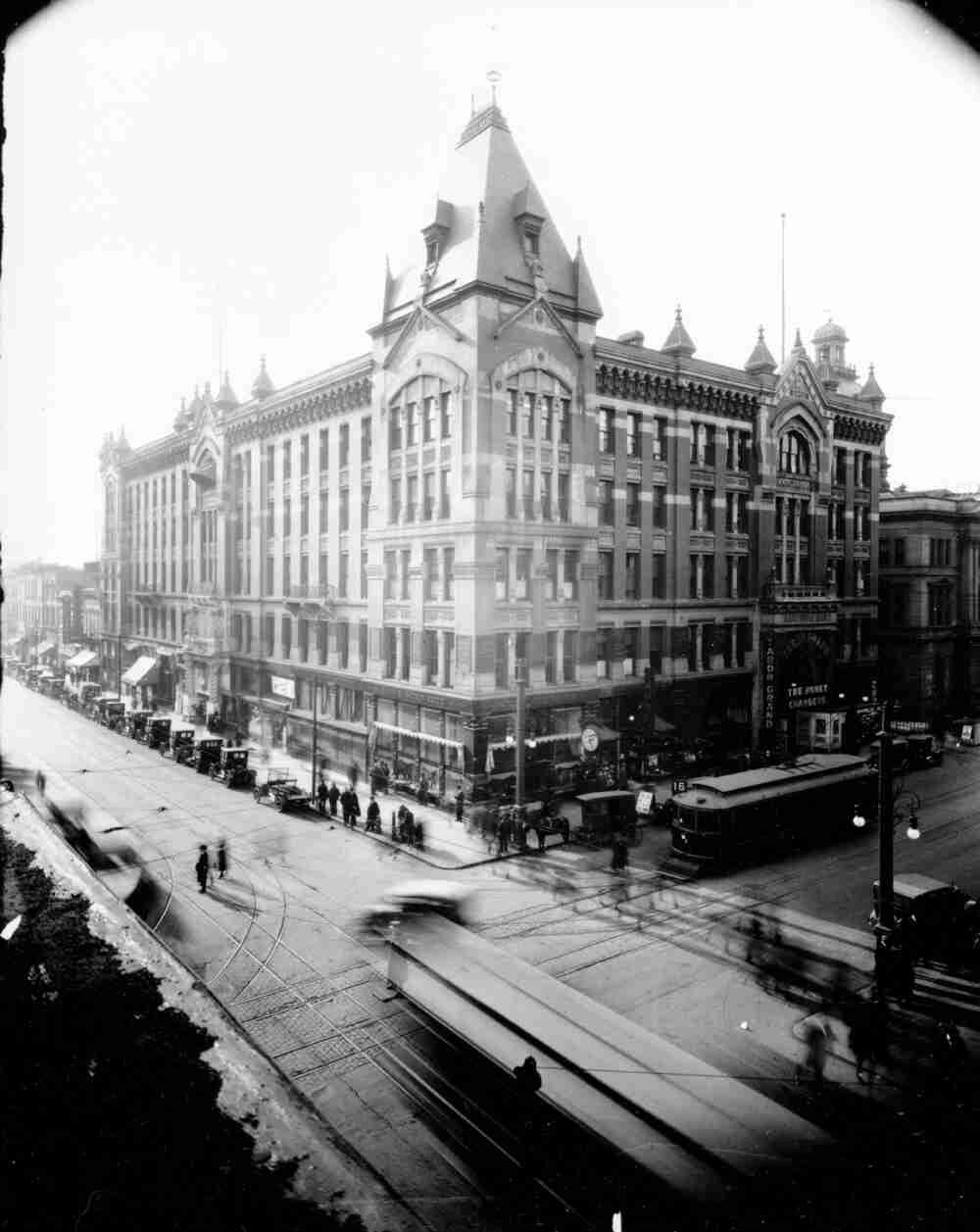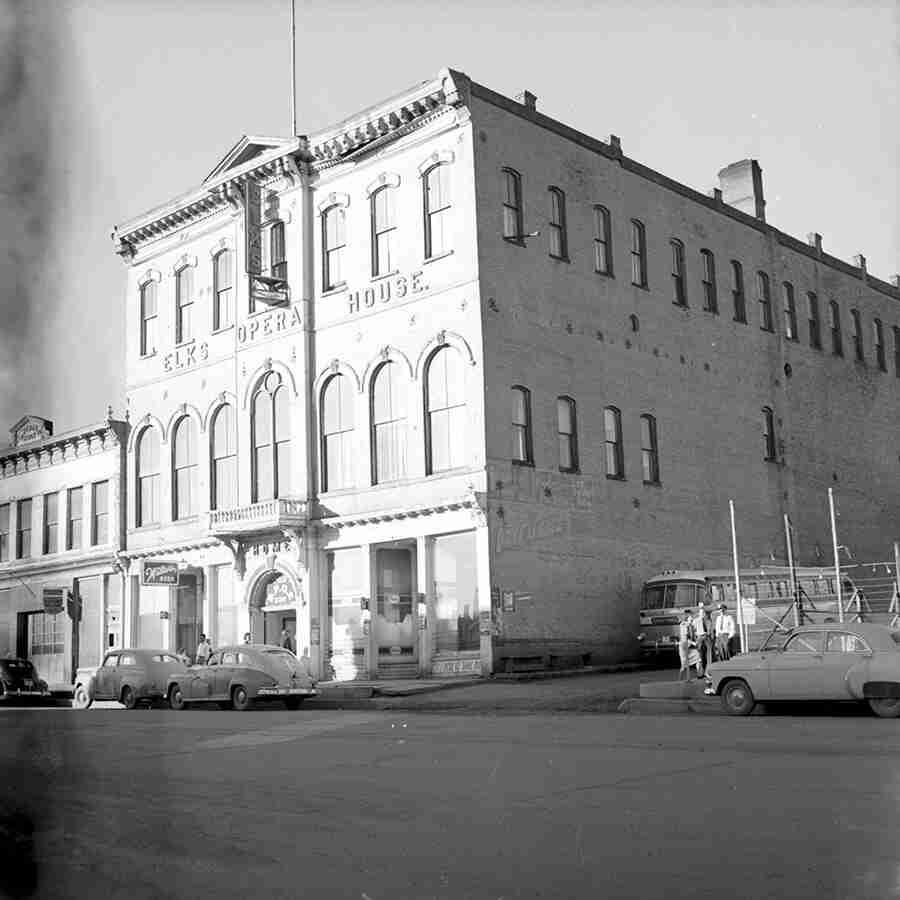Tabor Opera House
Full Article
The Tabor Opera House (308 Harrison Avenue, Leadville) was built by Horace Tabor in 1879 to bring high-class entertainment to the rough mining camp of Leadville. It was for a while one of the top theaters in the state. Horace Tabor had to sell the property during the Panic of 1893. It later was home to the Leadville Elks Lodge for many decades before being sold in 1955 to locals Florence Hollister and Evelyn Furman, who worked to preserve and maintain the building. Today the opera house is owned by the city of Leadville and managed by the Tabor Opera House Preservation Foundation, which presents performances there and is rehabilitating the historic building.
Grand Opera for a Booming City
Soon after its silver boom started in 1878, Leadville gained a well-deserved reputation as a rough place full of violence and vice. Local merchant, first mayor, and newly minted mining millionaire Horace Tabor attempted to tame the city by organizing a fire brigade, a telephone system, a bank, and a waterworks. He also believed Leadville deserved a high-class theater where residents could enjoy more refined entertainment than could be found in the red-light district on State Street. In summer 1879, he broke ground for a grand new theater building on Harrison Avenue next to the city’s first luxury hotel, the Clarendon, which had opened that spring. “It is to be the only legitimate theatre or the only place where respectable people need not be afraid to go,” reported the Daily Chronicle. “This has been one great need of Leadville for months.”
On November 20, 1879, Leadville residents flocked to the Tabor Opera House’s opening night, where they saw theater manager and actor Jack Langrishe stage a performance of a comedy called The Serious Family. They also got a good look at the building itself, a large, boxy three-story brick structure measuring 60 feet wide, 60 feet tall, and 120 feet deep. The ground floor had two storefronts framing the central theater entrance. Inside, patrons ascended a grand staircase to the second-floor auditorium. There they were greeted by more than 800 plush red chairs—about half on the main floor and half on the mezzanine—facing a stage said to be one of the largest west of New York City. The building’s second floor also held offices and private apartments for Tabor and Clarendon Hotel owner W. H. Bush, who had helped finance the opera house. The third floor served as a twenty-five-room expansion of the Clarendon, with a bridge connecting the neighboring buildings.
The opening of the Tabor Opera House signified that Leadville had serious cultural aspirations. Indeed, the opera house was for several years the second most important theater in the state, behind only the Central City Opera House. When the railroad reached Leadville in summer 1880, former president Ulysses S. Grant arrived on the first train and attended a performance at the Tabor that evening. Throughout the 1880s, the Tabor served as a stop on the Silver Circuit for touring theatrical companies, and it also attracted plenty of other national and regional tours, symphony orchestras, minstrel shows, and vaudevilles. Leadville’s most famous visitor, Oscar Wilde, gave a talk on aesthetic theory at the Tabor in April 1882, while Broadway actress Kate Claxton played there in 1881, Shakespearean actor Lawrence Barrett performed in 1883, and the Europeans Francesca Janauschek and Helena Modjeska also made appearances.
Nevertheless, once Leadville’s initial mining boom subsided and its many new millionaires moved down to Denver, the city and its cultural jewel started a slow slide into second-tier status. Horace Tabor embodied and even advanced the change; he was living mostly in Denver by 1880 and opened the Tabor Grand Opera House there in 1881, far outclassing all other theaters in the state. The Tabor Opera House in Leadville continued to attract top national shows, but each year the number of performances decreased and the season got shorter. By the end of the 1880s, the Tabor was able to offer first-class theatrical productions only once a week, with the rest of its schedule filled by local productions, speeches, meetings, and other community events.
After the Crash
The Panic of 1893 and the repeal of the Sherman Silver Purchase Act that year hit Colorado’s mining economy hard and destroyed many fortunes, including Horace Tabor’s. Tabor had to sell all his property in an attempt to stay afloat. He found it hard to part with his Leadville opera house, his first grand building that long served as his local residence, and it was reportedly the last possession he placed on the selling block. A local miner, rancher, and lawyer named Algernon Weston scooped it up for $22,000 and rechristened it the Weston Opera House.
During Weston’s ownership, the opera house continued to attract some top-tier entertainment as Leadville’s economy recovered from the 1893 crash. The best performances came infrequently, however, and typically stayed for only one night before moving on. In between, the Weston Opera House stage was home to minstrel shows and other B-level entertainment. One landmark event came in 1897, when the opera house hosted a “Wonderful Magniscope,” probably the first movie ever shown in Leadville. When Weston died that same year, ownership of the opera house passed to his widow.
By the early 1900s, Leadville was a productive but shrinking mining town, and Weston’s widow had a hard time attracting audiences to the opera house. In 1901 she sold the building to J. H. Heron, who soon resold it to the Leadville Elks Lodge for $12,000. The Elks planned to use the building’s upper floors as their meeting space while restoring the theater to its first-class status. After spending a reported $25,000 on renovations, including a smaller stage area that allowed for more seating, they reopened the theater in December 1902 as the Elks Opera House. The first performance was the popular musical comedy Florodora.
The Elks may have spruced up the opera house, but they could not change the trajectory of Leadville’s economy or national trends in entertainment. After making a brief splash with its reopening, the building continued its gradual, decades-long decline from being one of the top opera houses in the state to serving as a glorified local community center. National tours appeared less frequently and eventually stopped coming at all. To fill the stage, the Elks put on a regular vaudeville show and sometimes screened movies. Eventually, the theater was used primarily for local school and community functions. By the 1930s, when the neighboring Clarendon Hotel was torn down, the opera house’s formerly grand interior was becoming a bit shabby, while its exterior was starting to crumble.
Saving the Tabor
After World War II, Leadville enjoyed relative prosperity thanks to the profits of the nearby Climax Molybdenum Mine, and the city embarked on a project of modernization. Many old buildings were torn down and new structures put up. As part of this wave of renewal, the Elks decided to move out of their expensive old home and build a new lodge. In 1954 they listed the Tabor for sale and received a bid of $20,000 from a local woman named Florence Hollister, a retired schoolteacher who had moved to Leadville and become fascinated by the town’s history. After the Elks voted to accept Hollister’s bid, she took possession of the opera house in January 1955 with the goal of preserving and restoring an important piece of local history.
Working with her daughter, Evelyn Livingston Furman, who was also living in Leadville, Hollister immediately revived the Tabor Opera House name, patched up the leaky roof, and opened the building to public tours as a way of raising money for its restoration. Gradually Hollister and Furman restored parts of the building and worked to prevent further deterioration. After Hollister died in 1965, Furman continued the project herself. She ran the opera house for more than thirty years before turning it over to her daughter, Sharon Furman Bland, in the late 1990s.
Recent Preservation Efforts
In 2003 Leadville locals formed the Tabor Opera House Preservation Foundation to help the Bland family preserve and restore the building. Despite their efforts, it proved difficult to raise money to maintain the aging opera house. By the mid-2010s, there was a growing sense that urgent action was needed. In 2016 the opera house was listed as an Endangered Place by Colorado Preservation Inc. and deemed a National Treasure by the National Trust for Historic Preservation.
The Tabor’s listing as an Endangered Place and a National Treasure quickly helped mobilize new resources behind the building’s rehabilitation. In summer 2016, Colorado Creative Industries revived a miniature Silver Circuit as a fundraiser for historic theaters across the state, including the Tabor. By that fall, the city of Leadville had raised enough money from private donations and grants to buy the Tabor Opera House from the Bland family for $600,000.
After the city bought the building, the Tabor Opera House Preservation Foundation reorganized and started to focus on fundraising for repairs as well as operating the building in line with consultant recommendations. In 2017 the foundation presented its first full season of performances at the opera house, followed in 2018 and 2019 by a steady flow of musical performances and local cultural events. In 2020 the first phase of rehabilitation work will begin with repair of the masonry and windows on the building’s exposed west and south facades. Fundraising is ongoing for future phases of work, which are planned to repair the rest of the building’s exterior; revive its historic storefronts; rehabilitate the interior; provide greater accessibility’ and improve power, lighting, and ventilation.



















